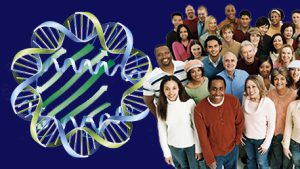From Genomics to Proteomics— What’s the Impact on Population Health?
Posted on by Advances in genomic sequencing technology are transforming medical discovery, enabling researchers to conduct comprehensive explorations across whole genomes for individuals and populations. Genomics has led to valuable insights into the complex processes influencing health and disease. It has paved the way for studying how genes regulate the most basic functions of the cell, including what proteins to produce and how to make them.
Advances in genomic sequencing technology are transforming medical discovery, enabling researchers to conduct comprehensive explorations across whole genomes for individuals and populations. Genomics has led to valuable insights into the complex processes influencing health and disease. It has paved the way for studying how genes regulate the most basic functions of the cell, including what proteins to produce and how to make them.
New insights into the genome have led to the emergence of proteomics, the study of the structure and function of an individual’s entire set of expressed proteins. Proteomics is highly linked to genomics, since the blueprint for each protein is inscribed on an organism’s genes. This field of study has great potential for advancing health and medicine, as described in this recent JAMA article.
Mapping the Human Proteome
Unlike genes, proteins change over time; they are continuously synthesized, transported, modified, and degraded. The life cycle of a protein starts with a blueprint transcribed from a gene, followed by folding, which translates the blueprint to a three-dimensional structure that allows it to carry out its biological function, and ends with degradation. The turnover of proteins is one of the cell’s most essential processes and is necessary for responding to external stimuli and for maintaining homeostasis. When a cell is perturbed, it responds by altering expressing levels of specific proteins and adjusting cellular functions in response to the new environmental stimuli. Studies of the human proteome have enabled scientists to track protein synthesis, modification, and degradation over time and across different cell types. Proteomics provides valuable information on cellular activities, which is integral for identifying and monitoring clinically relevant biomarkers, advancing our understanding of health and medicine.
Because the proteome is a continuously changing set of proteins that differs from cell to cell, it is challenging for scientists to capture and study it. In 2014, scientists developed a draft map of the human proteome, which catalogued proteins encoded by over 17,000 human genes, or about 84% of all protein-coding genes in the human genome. This year, scientists released a more complete map of the human proteome estimated to include more than 90% of the human proteome. By cataloguing the molecular processes by which cells maintain and modify protein levels, proteomic studies offer another dimension of information that may help advance our understanding of health and disease.
Translating Proteomic Discoveries into Population Health Benefits
A key challenge in medicine and public health is the translation of scientific discoveries to health applications. Translating proteomics research findings is challenging in the face of complex and dynamic cellular-level processes. Integrating data across domains may help reveal important relationships. For example, by integrating genomic and proteomic data, proteogenomics is providing new insights into cancer biology and revealing potential therapeutic targets. In addition, proteomics provides unique tools for the discovery of cancer biomarkers, which could help in the early diagnosis and risk stratification of cancer. For example, a recent article in Nature Communications described proteomic profiling of 300 breast cancer samples, which revealed biological subtypes with distinct clinical outcomes and different survival rates. Another recent study used proteomic profiling of liver biopsies to describe the molecular landscape of hepatocellular carcinoma, the most common type of liver cancer.
Challenges of Proteomics and Its Future
As proteomics becomes more prevalent, methods of evaluation will become integral to its value in medical applications. Some challenges for translating proteomics include technical issues in measuring proteomic markers, identifying clinically useful markers in patient samples, the need for large sample sizes to be able to distinguish protein variability among samples, and challenges in implementing strict protocols for sample handling. Most importantly, proteomic interventions will have to be evaluated for their ability to improve health outcomes, using observational studies and clinical trials.
Building the evidence base for use of proteomic markers in clinical practice requires evaluation of their performance for each clinical scenario. One strategy would be to use the CDC ACCE model . ACCE has been a useful tool in the evaluation of the performance of genetic tests for nearly two decades. It has a comprehensive list of targeted questions concerning the Analytic validity, Clinical validity and Clinical utility of a genetic test, along with Ethical, legal and social implications.
While proteomics has the potential to inform medicine and public health, the translation of proteomics from basic science to clinical application must cross the “valley of death,” where most promising scientific discoveries meet their demise. As with genomics, there are no shortcuts on the translation highway from discovery to improving population health.
Get Involved in Proteomics
There are many publicly accessible resources for studying the proteome. The Human Protein Atlas (HPA) is an open-access database containing protein expression data in cells, tissues, and organs with datasets made freely available to encourage further studies in the field. Uniprot is a public resource containing protein sequence and functional information with an aim to support proteomics research by linking a complete compendium of all known protein sequence data to a summary of experimental or computational studies of the protein. Currently, the UniProt Knowledgebase (UniProtKB) contains over 220 million protein sequence records, and will continue to scale as the volume of sequence data continues to grow.
Please let us know your thoughts and comments on proteomics below.
Posted on by


